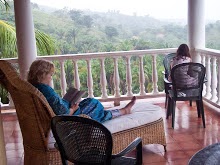I thought I would start getting back into the habit of blogging by introducing you to the Pech Indians around Trujillo. First, a little history. The Pech are found in the Northeastern areas of Honduras. They were at one time one of the larger of the indigenous people. Today, they number less than 2,000, and live in about 9 small villages. There have been Pech ruins found that date back to 300 CE. They are traditionally hunter-gatherers, but they are rapidly being assimilated into the Latino culture as their hunting grounds and general habitat is being destroyed in the name of progress.
The leaders in the local village of Moradel are Doña Juana Martinez and her son, Profesor Angel Simeon Martinez. Profesor Angel is certified to teach the Pech children in their own language, in an effort to keep the language from becoming extinct. Doña Juana and her family are trying to keep alive the old crafts that they make from natural resources, such as gourds, grasses, flowers, etc. She also makes medicines from local plants. She is the village curandera and uses her medicines to provide for the village. I can attest to the fact that some of them work better than traditional Western medicine.
Doña Juana Martinez, leader of the local Pech village, in her little souvenir shop. Behind her are some of the crafts she and her family make. The bag is of a fiber made from local grasses. It is dyed with natural colors derived from plants. The natural color is the light ecru color. The little bowls are made from various gourds, and are used for dishes and cups. Just over her head is a hanging basket for storing foods, or anything else, that you want to keep critters out of. The things made from fiber are woven together in a technique that can best be described as crocheting just using the fingers, with no crochet hook.
 |
| Pech Ángel Simeón Martínez representing his people at a conference at the Universidad Nacional Autónoma de Honduras. |


The village of Moradel is hidden in the forest just off the main highway. There is a sign at the turn-off, but it is difficult to find the village unless you know where to look. When you get there, each family has their own little plot, and they are not easy to see from the road. They build for privacy, and they do it well.

This is the inside of the kitchen. The white structure is the stove, where Doña Juana cooks the family meals. It is wood fired. The lower part is the oven. She is a good cook, but let me tell you, Pech food is VERY spicy. She cooked food for me when I visited one time, and my mouth was on fire for an hour. She also makes a low alcohol corn beer here. It is is so mild that even children drink it. It is suppose to give you strength when it is hot. It is an acquired taste. The little woman in the door is Doña Paulina, Doña Juana's 85+ year old mother. Eight people live here.
This is just one of the indigenous peoples in our area. They are among the poorest, but I have never been to Moradel that I wasn't offered something to eat or drink, if only cold water served in a cup made from a gourd.
We are blessed.





